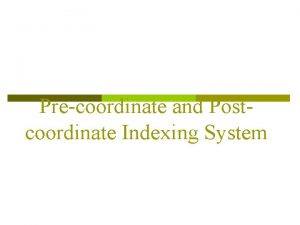GOALDIRECTED ASR IN A MULTIMEDIA INDEXING AND SEARCHING

- Slides: 1

GOAL-DIRECTED ASR IN A MULTIMEDIA INDEXING AND SEARCHING ENVIRONMENT (MUMIS) Mirjam Wester, Judith M. Kessens & Helmer Strik 2 RT, University of Nijmegen, The Netherlands A English results Dutch results Speech Material The commentator(s)’s speech was orthographically transcribed by SPEX. Test material was taken from the Yugoslavia - The Netherlands match. Table 1: Number of words in test set, per language. ¼ of match Dutch English German 1577 2641 1000 Dutch English German selection Mumis Yug-Ned + Eng-Dld Yug. Ned Eng-Dld Eng. Dld test set Matched training/test data leads to best performance. Cross-testing shows increase in WERs. Lower SNRs lead to higher WERs WER for different word types Results of adding additional MUMIS data. Split words into categories, i. e. football player’s names, content words and function words. Table 3: Selection of matches according to average SNR values. Mean SNR d. B (std) 24 h 37 m 36. 1 (5. 3) SNR classification A=very noisy 12 h 32 m 36. 6 (5. 4) B=noisy Port. Dld, Ned. It + Fra. It 19 m 9. 4 (2. 9) C=semi-clean Port. Tur + Eng. Port 18 m 8. 2 (2. 8) noisy and semi-clean Yug-Ned 29 m 12. 1 (3. 6) D=minus very noisy Eng-Dld 34 m 10. 8 (3. 3) Yug-Ned 14 m 10. 9 (2. 7) Eng-Dld 24 m 6. 9 (1. 7) Dld-Rom 21 m 7. 4 (2. 5) Port-Dld 33 m 8. 5 (2. 9) Ned-It 24 m 9. 2 (2. 8) Port-Tur 30 m 19. 5 (4. 2) Fra-It 34 m 11. 3 (3. 4) Eng-Port 23 m 15. 2 (4. 3) all speakers Polyphon male e speakers Yug-Ned MUMIS Eng-Dld MUMIS duration speech Yug. Ned test set Speech Recognizer Standard HMM system; features are 14 MFCCs + deltas Acoustic Models: sets of phones derived from SAMPA: English 40, Dutch 37 and German 34, plus a non-speech model. Lexicon: Most transcriptions derived from CELEX, missing words were transcribed manually. Language Model: Trained on orthographic transcriptions for each match. For each utterance the SNR was calculated. The utterances were grouped into 2 d. B wide bins according to their SNR values, and the WER for each bin was calculated. Only bins containing > 100 words were considered. German results Table 2: Sets of training material available per language. languag material e Yug-Ned + Eng-Dld Yug. Ned polyphone MUMIS Training materials Matched training/test data leads to the best performance. Using Polyphone training data does not lead to lower WERs than using MUMIS training data; even though it comprises more data. Noisifying Polyphone data with MUMIS noise leads to a substantial improvement. WER for different SNR values Results for cross-testing Yug-Ned and Eng-Dld Yug-Ned + Eng-Dld Yug-Ned male + noise male This study concentrates on the automatic speech recognition (ASR) portion of the project. The data comprises commentaries accompanying the EURO-2000 football matches for: Dutch English German The goal of this study is to illustrate the feasibility of using ASR technology to transcribe the spoken commentaries that accompany football broadcasts. Results for different sets of training materials. all The MUMIS project aims at creating a simple user-interface which can be used to query a video archive containing football matches. For more info see: http: //parlevink. cs. utwente. nl/projects/mumis. html Eng-Dld Introduction matches Eng. Dld+Dld. Rom Function words cause a great deal of the errors (and make up 50% of the words). The application specific words, players’ names, are recognized best. Increasing amount of training data Conclusions At first adding more data leads to lower WERs, however a floor seems to be reached after adding about 90 minutes training data. The training data was added as it became available. . . However, a selection based on matching or similar SNR values may be better. See Table 3 for the various selections. SNR values explain the WERs to a large extent. More data is not necessarily better. Matching the SNR values of training and test material leads to best results. Overall WERs are very high, but application specific words are recognized quite well. The best result is obtained when the training data matches the test data, i. e. Yug. Ned, or when matches are selected for training with similar SNR values, i. e. the noisy selection (B). Acknowledgments: This work was carried out in the context of MUMIS, an EU funded project within the Information Society Program of the European Union, section Human Language Technology. (IST 10651) Ongoing work Generic language model and lexicon. Speaker adaptation. Transcription of more German data.

